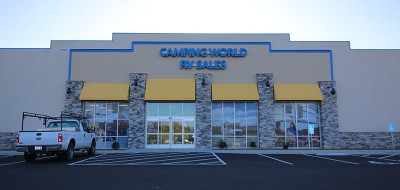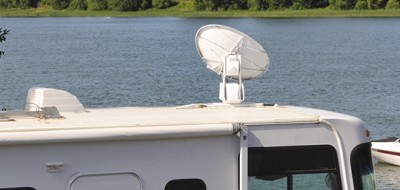 New and improved technologies are emerging faster than some of us can load and unload our RVs. From Wi-Fi to Wii, from iPods to XM and from satellite TV to DVDs, our mobile entertainment options have exploded – and keeping up with them can be daunting.
New and improved technologies are emerging faster than some of us can load and unload our RVs. From Wi-Fi to Wii, from iPods to XM and from satellite TV to DVDs, our mobile entertainment options have exploded – and keeping up with them can be daunting.
Here’s the low-down on high-tech RV entertainment accessories and tips for using them.
Wireless Fidelity (Wi-Fi)
With the boom of Wi-Fi hotspots (and many of them free), there is no longer any reason you should be hauling your computer around in search of a modem connection.
What is it? Wi-Fi has become the term used for the technology behind products that use radio frequency to communicate. One form of wireless is mobile wireless – the ability to move almost anywhere while staying connected to the Internet.
How do I use it? First, you’ll need a wireless client card. Most computers and PDAs today have this feature built in. If your computer isn’t already Wi-Fi enabled, you can purchase the wireless client card at a computer, office supply, electronics store, or even on e-Bay for about $50. When you’re shopping, look for a product that specifies it’s Wi-Fi certified or 802.11b compatible.
Once you confirm your computer is Wi-Fi enabled, you’ll need to download software that will locate hotspots (places where wireless Internet access is available) and connect you to them. Two popular wireless providers among RVers are Boingo and Hotspotzz. Many RV parks and campgrounds offer Wi-Fi connections. Some offer free access, but sometimes there’s a pay-as-you-go fee.
Satellite Radio
Keeping the soundtrack to your life running – without annoying commercials – whether you’re driving through congested streets of Chicago or through the Sierra Nevada mountain range, has never been easier with satellite radio.
What is it? Also called digital radio, satellite radio offers uninterrupted, digital music beamed to your radio from space. The two major radio subscription services are XM radio and Sirius.
How do I use it? Although some new RV models come equipped with satellite radio systems, most of us have to install and purchase them after-market. With both XM radio and Sirius, you can either purchase a portable unit that can be taken from home to vehicle, or you can install a receiver in your RV. Once you’ve purchased the receiver, you pay a monthly subscription fee for the service. Although they use slightly different technology, both XM Radio and Sirius deliver clear sound and quality programming. Compare channel listings to see which you’ll enjoy more.
Satellite TV
Hundreds of thousands of RVers have taken advantage of watching television on the road and many luxury models include it as a standard package. For the rest of us…
What is it? It’s wireless system for delivering television programming directly to your home or RV via broadcast signals from satellites orbiting the Earth. Since satellites are high in the sky, there are a lot more customers in the line of site. Satellite television systems transmit and receive radio signals using specialized antennae.
How do I use it? There are many more options when it comes to setting up satellite television, but most systems include a small satellite dish, a receiver and a remote control.
There are two types of dish antennae: manual, which is less expensive but requires some effort in pointing the dish in the right direction and keeping it there; and automatic, which costs more but automatically points toward the system. There are also mounting options. You can either install a standard roof mount or use a dish tripod. There are three major RV dish suppliers: KVH, Winegard and King Controls, Camping World has a huge variety of RV hi-tech satellite tv and radio equipment for you to choose from.
Once you install the receiver and dish, you’ll subscribe to one of the satellite TV service providers, DIRECTV or Dish Network, which charge a monthly service fee.
This article was brought to you by Good Sam RV Emergency Road Service






Pingback: bns gold
Pingback: my url
Christy @ Technosyncratic
When we first started living in an RV fulltime, we put a lot of research into mobile internet options for RVers because we also work online. There are a ton of options out there to choose from, but we eventually settled on 3G mobile internet through Millenicom and have been very happy with it.
carolyn rose goyda
hi
can you supply some more info on the antenna to boost cell signal??
how do you link the bell to antenna ?? i am confused
Rick Vogel
I Have had sirius radio since 2006, Got 85 mg’s of I-Pod Player now that is hooked into the surround sound & the out-door speaker’s, Have Verizon wireless for 17″ H.P. Lap-Top P.C. Have 42 ‘sanyo flat screen & 27 in Master Bedroom & a 17 ‘ flat-screen against the fireplace in the middle of the coach, I can use Wi-Fi as well as a cell signal & have a 10 ft. antena with a magnet base to boost the cell signal from Verizon Wireless! Work’s Great! Use it every-day! Rick Vogel U.S.Army Retired
Harold Peterson
I have a 2007 Newmar Mountainaire and have 4 HDTVs plus a Kingdome HD satellite. I hooked up the Direct TV HD receiver expecting to receive HD tv on all my tv’s. What happened instead is a message on screen that said the wiring was not able to accept the HD signal. I have contacted Newmar, Kingdome and Direct TV and all say it is the problem of the other vendors.
Have any of you ever been confronted with this problem and if so, what did you do to resolve it.
Rick
We have been using a product called Wifi in Motion. It is a system that basically converted our RV into our own “hotspot.” It uses cellular technology, and so far, so good! We have been very happy with it, along with the support. It was easy to install, and when we aren’t on the road, we use it for our Internet access for our brick-and-mortar home, or the occasional hotel stay.
Great article!
Rick
Cindy and Randy
We use Sirius radio and have been very happy with it. Since they charge for every separate radio you use, we transfer the one from car to RV when traveling.
We depended on wifi for several years, but finally gave in and got a Verizon aircard. It costs around $60 amonth and has given good broadband reception in almost all areas we’ve been around the US, some better than others. Nice not to have find parks or coffee houses that carry wifi. It also has better security since there is no network of other users. And the added benefit of being usable while driving. Don’t know why we waited so long to get it.
Good Sam ERS
Boingo and Hotspotzz are a network of internet access providers where you have take your laptop to a location that has this sponsored wireless internet supply. You pay them a monthly fee and you can use 1 of 100,000 hot spot locations world wide to use their wireless internet access. These “hot spots” are located in cafes, hotels, airports, restaurants and coffee shops, where you must be within a 100 foot umbrella radius of the reception to get their wireless internet access feed. The network card in your laptop computer should be able to connect directly to the service that they supply.
Here is the link to Boing’s global hot spot locator: http://boingo.jiwire.com/
Hotspotzz is the same thing, but seems to be having internet issues right now, but they also have a locator to find locations.
When you speak of “deadzones”, I am unclear to what you mean. If you are referring to the Hot Spot method of getting internet and you are traveling, you are going to be hitting a lot of deadsones because you must be within 100 feet or less, depending on the strength of the wireless internet signal in that particular hot spot.
Also, I have another story on mobile internet that you may want to read:
http://blog.rv.net/2008/08/28/internet-in-your-rv/
If you take a look at the comments at the bottom, people are now able to get mobile access to the internet over cell phone signal technology. That means anywhere most cell phones work, you should be able to get internet access. There is a bit of a buy in to get this benefit, but if you’re up for it, the technology is there for you.
Another method to getting internet while you are traveling and out in the middle of nowhere is satellite internet. There are companies out there like Direcway or now called HughesNet, where you can get a satellite dish and then you can get internet anywhere on the planet, provided you have a clear line of sight and not under a bunch of trees or a major blockage. http://go.gethughesnet.com/. Camping World, http://www.campingworld.com, sells a large variety of mobile internet products and they’ll even do the installation for you.
I hope this helps! Good luck!
Louella Giddings
I’m getting ready to set out for the winter and after reading your article was wondering about Boingo and Hotspotzz. Can you tell us computer illiterates more about these two? Do I need to belong to something like this to make access to the internet easier in dead zones or is the card in the computer all that I need?